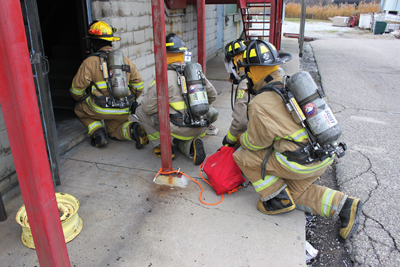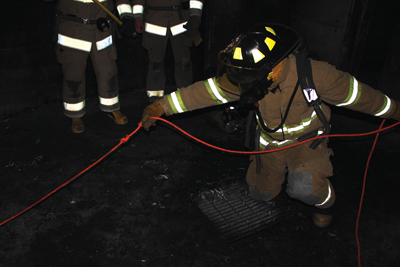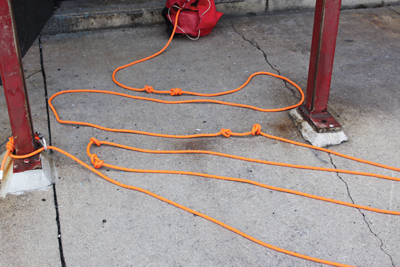
Back to Basics: January 2010
Mark Van
Features Fire Ground TrainingIn October we discussed tactical considerations when searching for an
injured, trapped or lost firefighter and we looked at the differences
between a search for a civilian and a search for a firefighter. Here we
will review tactical considerations when locating a firefighter with a
search rope, or lifeline.
In October we discussed tactical considerations when searching for an injured, trapped or lost firefighter and we looked at the differences between a search for a civilian and a search for a firefighter. Here we will review tactical considerations when locating a firefighter with a search rope, or lifeline.
 |
|
| Photo by Mark van der Feyst. A four-person RIT (Braeden Mackenzie, Justin McRae, Sera Lapointe and Joshua Graham from Lambton College in Sarnia, Ont.) ready to deploy the search line. The last man has the rope bag and is tasked with managing the search rope. The first step is to secure the search rope around an object outside the structure.
|
When incident command receives a mayday call from a firefighter, seconds count. We train our fire-service professionals to respond to calls that involve human life in the balance and we need to respond to a mayday call in the same fashion.
A search rope, or a lifeline, can help us quickly locate a mayday firefighter. When a firefighter declares a mayday we need to act quickly to locate him. We teach firefighters to maintain contact with the wall of the structure during a search. Using either the left or right hand to ensure that there is contact with the wall, they are better able to find the way out. This method adds to the time it takes to locate a mayday firefighter.
Using a search rope enables us to head directly to the firefighter by using our sense of hearing. For this method to work, the personal alert safety system (PASS) alarm must be turned on by the mayday firefighter. If the mayday firefighter is unconscious, not moving, pinned or trapped, his PASS alarm will go off automatically. If the firefighter is conscious and able to move, he must turn on his PASS alarm to indicate his location to the RIT. The search rope allows the RIT to forget about a left- or right-hand search and head directly to the PASS alarm. The search rope acts like a trail of breadcrumbs to lead the RIT out and to help other RIT members going in to assist or relieve.
 |
|
| Photo by Mark van der Feyst. Firefighter Joshua Graham reads the search line by locating the knots – one knot in, two knots out.
|
A rope between 7.5 millimetres and nine millimetres thick is ideal for use as a search rope. This width allows the rope to be used to its full capacity, provides good mobility for the RIT and allows the RIT to carry 100 feet of rope without adding too much size or bulk. Within the length of the search rope there should be a series of knots tied at regular intervals (see photo page 33), one knot followed by two knots. This system of knots allows any firefighter to read the rope to find the way out. RIT firefighters can become disoriented and lost but if they can locate the search rope they can read their way out. These knots need to be spaced so that at any point on the search rope a firefighter can grab the rope with both hands, fully extend his left or right hand and come across a set of knots. A good knot interval is about eight to 10 feet. The knots tell the firefighter which way to head; one knot is the way in to the firefighter; two knots is the way out. A simple way to remember this is “one way in, two ways out” (see photo below).
Who deploys the search line? Ideally, we want four people on our RIT. This makes the operation work more efficiently. Typically though, we see two-person RITs. Two-person RITs have to do a lot of work. They are going to carry a RIT pack or SCBA, hand tools, thermal camera and a search rope. This is a lot of equipment to be carried by two people. Usually we teach two-person searches using the structure as a guide without search rope. A two-person team can use a search rope if desired but this means sacrificing another tool. A four-person team can use the search rope much more effectively (see photo page 30). The search rope is deployed by the last person entering the structure: this way the rope will not get tangled by RIT members. The job of the fourth person is to manage the search rope. This starts with securing the search line around a solid source outside the structure such as a tree, iron railing, lamp post or column.
 |
|
| Photo by Mark van der Feyst. The RIT search line needs to have a series of knots placed at even intervals of about eight to 10 feet.
|
Once the RIT enters the structure, the fourth person ensures that the rope plays out from the rope bag untangled, that it does not get caught on furniture and that it does not get snagged at corners. When the mayday firefighter is located, the fourth RIT member ensures that the rope line is in position to be followed out. This entails getting all of the slack out of the rope, ensuring that it is taut and making sure the remaining rope is out if the way of the RIT members.
Lighted rope is also an option and has been on the market for about 10 years. Lighted rope provides a pathway and has an electrical receptacle at the end for electrical hand tools. Within the lighted rope are coloured lights at regular intervals. The lights are red and green. The red lights indicate the way into the fire and the green lights indicate the way out. Lighted rope is heavier and not as mobile as a search rope. It is also costly.
Using a search rope speeds up the search process for the RIT. It works well only if firefighters are trained in this technique and the equipment is at hand when the mayday occurs.
Mark van der Feyst is a 10-year veteran of the fire service who works for the City of Woodstock Fire Department in Ontario. Mark teaches in Canada and the U.S. He is a local level suppression instructor for the Pennsylvania State Fire Academy, an instructor for the Justice Institute of BC and an associate professor of fire science with Lambton College in Sarnia, Ont. He can be reached at Mark@FireStarTraining.com
Print this page